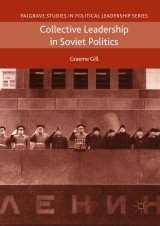Details

Collective Leadership in Soviet Politics
Palgrave Studies in Political Leadership
|
128,39 € |
|
| Verlag: | Palgrave Macmillan |
| Format: | |
| Veröffentl.: | 21.03.2018 |
| ISBN/EAN: | 9783319769622 |
| Sprache: | englisch |
Dieses eBook enthält ein Wasserzeichen.
Beschreibungen
<p>This book studies the way in which the top leadership in the Soviet Union changed over time from 1917 until the collapse of the country in 1991. Its principal focus is the tension between individual leadership and collective rule, and it charts how this played out over the life of the regime. The strategies used by the most prominent leader in each period – Lenin, Stalin, Khrushchev, Brezhnev and Gorbachev – to acquire and retain power are counterposed to the strategies used by the other oligarchs to protect themselves and sustain their positions. This is analyzed against the backdrop of the emergence of norms designed to structure oligarch politics. The book will appeal to students and scholars interested in the fields of political leadership, Soviet politics and Soviet history. </p>
<p>Chapter One. Introduction. The Study of Soviet Leadership.- Chapter Two. Oligarchy with a Predominant Leader, 1917-22.- Chapter Three. Rule by Pure Oligarchy, 1923-29.- Chapter Four. From the Predominant to the Dominant Leader, 1930-53.- Chapter Five. The Limits of the Predominant Leader, 1953-64.- Chapter Six. Predominant Leader within the Collective, 1964-82.- Chapter Seven. Collectivism Collapses, 1982-91.- Conclusion.</p>
<p><b>Graeme Gill</b> is Professor Emeritus in the Department of Government and International Relations at the University of Sydney, Australia. The author or editor of more than twenty books, as well as Soviet and Russian politics and history, he has published on the role of class in political development, the state and democratization. </p>
<p> </p>
<p> </p>
<p>This book studies the way in which the top leadership in the Soviet Union changed over time from 1917 until the collapse of the country in 1991. Its principal focus is the tension between individual leadership and collective rule, and it charts how this played out over the life of the regime. The strategies used by the most prominent leader in each period – Lenin, Stalin, Khrushchev, Brezhnev and Gorbachev – to acquire and retain power are counterposed to the strategies used by the other oligarchs to protect themselves and sustain their positions. This is analyzed against the backdrop of the emergence of norms designed to structure oligarch politics. The book will appeal to students and scholars interested in the fields of political leadership, Soviet politics and Soviet history. </p>
Analyses the tension between individual leadership and collective rule Covers the entire Soviet period and all Soviet leaders Links the Soviet period to literature on authoritarian rule
<p>“The study of leadership has always been important, but seldom more so than today. In this masterful study of leadership patterns covering the whole Soviet period from 1917 to 1991, Gill stresses the shifting patterns between collective and individual leadership, and the crucial importance of elite unity for regime survival. In an era when authoritarian leadership is once again the centre of attention, this landmark study is essential reading in helping us understand patterns of authority and leadership survival.” (Professor Richard Sakwa, University of Kent, UK)</p><p>“This is a meticulous study of an important aspect of Soviet elite politics. Gill’s treatment is comprehensive, detailed, and compelling. The volume confirms long understood norms of Soviet leadership while also yielding new insights that will be valuable for even the most seasoned specialist. Drawing upon a rich array of sources, this is an important book that draws the reader into the labyrinth of Soviet elite politics.” (Professor John Pat Willerton, University of Arizona, USA)</p><br>

















